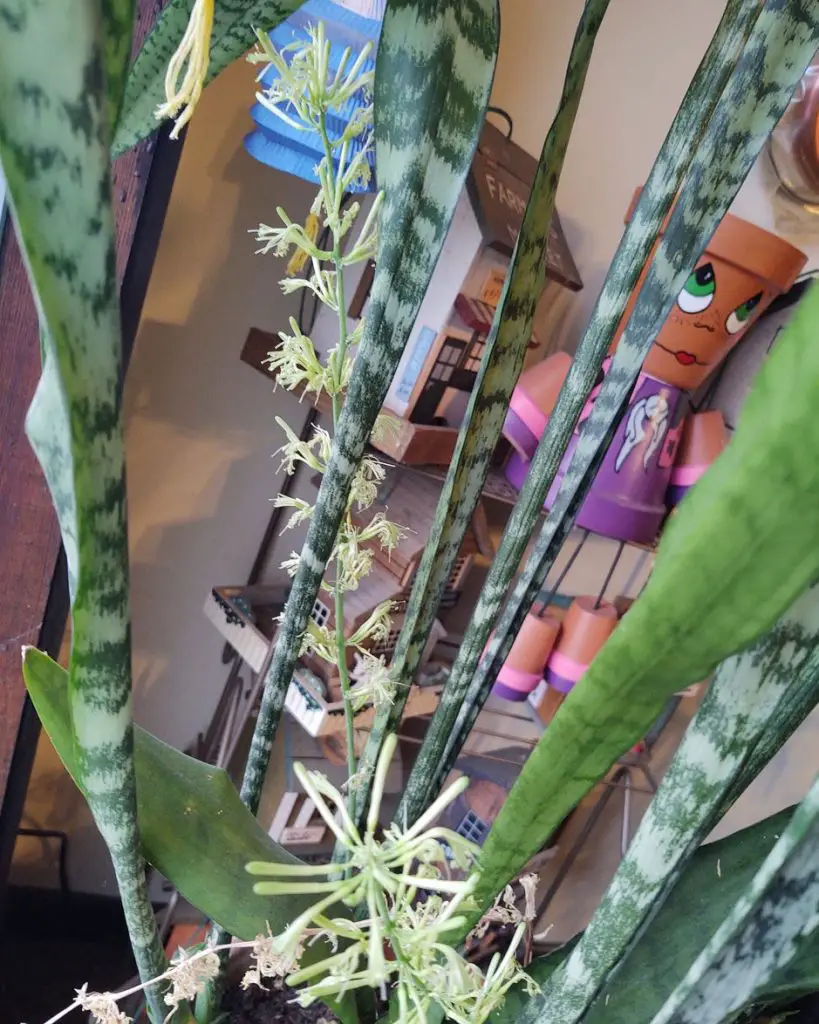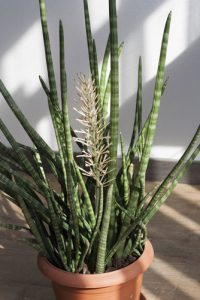How To Get Your Snake Plant To Flower: Yes! This Houseplant Will Bloom.

This post follows our research editorial guidelines.

Aside from being one of the most air-purifying plants, snake plants are known for their stiff, green foliage which looks very pleasing indoors. However, snake plants (Sansevieria) are not known for blooming like other indoor plants.
If they do so, it is quite rare and happens just once in a year. But is it really a good sign? Or something you should be worried about?
In this blog, I will discuss the possible reasons behind flowering in snake plants and also tell you how to get a snake plant to bloom again!

Table of Contents
Why is my Snake Plant Flowering?
Snake plants flower in an attempt to survive in arid conditions when the plant is getting too much sunlight and not enough water. This is an evolutionary trait in which the snake plant channels energy away from withering roots and puts it in producing new flowers for the next generation to spread through seeds.
By doing this, plants can decrease the chances of biotic extinctions and ensure progressive succession. Conversely, many people also associate flowering with luck as it happens rarely. These evergreen perennials have been long treasured in Brazilian, Chinese and African cultures where they were placed near the entrance of houses.
The third reason why your snake plant might flower is due to stress. This generally happens when your plant is root bound or due up for potting. However, this is not always the case.
Whether or not your snake plant will flower also depends on the type, as this is more common in certain varieties than others.

Sansevieria Robusta
Sansevieria Robusta, originally from India, is a rare plant variety which is also called the ‘bulletproof plant’. This is because of its hardiness and ability to thrive in the harsh conditions. In comparison to other snake plant types, its leaves are broader and shorter in length with yellow-green cross-banding.

Sansevieria Trifasciata
Also known as mother-in-law’s tongue due to its pointed leaves, this type of snake plant grows a long flower stalk covered in buds. Even though these flowers are not bad for your plant, they do indicate that your plant is stressed.
These flowers have a pleasant aroma and may fill the room with a fragrance which somewhat resembles lilies. On the flipside, you might also attract insects into your house due to this.
Sansevieria Twist
This varietal has twisted leaves which point upwards and does not grow as tall as the Sansevieria Trifasciata. You can identify this kind of snake plant by its yellow and green foliage. This house plant grows about 1-2 feet tall and then ceases leaf production if it is flowering.
Sansevieria Trifasciata is most likely to flower among all snake plant types. Some other flowering varieties are the Sansevieria Cylindrica and Sansevieria Kirkii ‘silver blue’.
Is a Snake Plant Supposed to Flower?

As mentioned above, flowering in snake plants is an innate survival trait. When the plant senses that it is about to die, it starts producing flowers so that it can produce seeds and live again.
Possible reasons for stress in your snake plant could include improper lighting, over or under watering and root rot. An ideal solution in such a case would be to inspect the plant thoroughly and look for signs of any bacterial infestation.
Then, you should check if your plant’s pot is bulging outwards from a certain area. This usually happens when plant roots get overcrowded underneath the surface. Your snake plant is more likely to flower if it has matured.
If you do not find any negative signs even after thorough monitoring, then you probably should not worry. Some theories also state that a plant may bloom when it is getting the right amount of water, nutrients and sunlight, but they are not backed scientifically.
If you do not see a problem, just sit back and witness the rare flower that not many people have the fortune to see!
Snake Plant Flower: At a Glance
Blossoms of the snake plant emerge on a slender stalk from the plant’s crown. You will see a cluster of white-greenish flowers near the top end of the stalk. These flowers are commonly greenish-white in color and last for 3-4 weeks before withering and dying.
Soon after this, the plant will start producing tiny plant pups which are an extension of its rhizome. Many plant owners like to propagate their snake plants by separating the pup via soil division and placing it in a new pot to make space for the parent plant.
These flowers always grow around tall stalks which can be several feet tall amidst a bunch of honeysuckle-like narrow-petaled flowers. Some varieties have a white base with a purple undertone whereas others show a dark shade of red.
Snake plant flowers close during the day and give out a strong & pleasant smell during the night.
As for the fragrance, this flower has an unmistakable spicy vanilla-like fragrance. The nectar from these flowers is so fragrant and abundant that it runs down the stem.
How Often Does a Snake Plant Flower?
Snake plants bloom once annually around the springtime. Furthermore, this is not a trait which is common in snake plants, so don’t get your hopes high up on seeing your snake plant bloom every year. According to sources, only 1 in 100 snake plants flower!
Your snake plant might grow flowers year after year, or could grow them once and not for a decade. It is also worth noting that this is more common in plants which are kept outdoors.
This is because unlike indoor/filtered light, which only has 2-3 wavelengths, sunlight hits the plant with a full spectrum. Constant exposure to sunlight might damage the plant tissues since snake plants store water in their thick stems, thus triggering flowering.

How to Get a Snake Plant to Bloom?
Given how rare it is to see a snake plant bloom, there is no method that guarantees the growth of flowers in a snake plant. Here are some ways by which you can increase the chances of your snake plant flowering:
- The easiest strategy to encourage flowering in snake pants is to provide plenty of sunlight and to keep them in a root-bound state. You can do this by placing your plant in a smaller sized pot, so it forms a mass of roots that occupy all the space inside. However, doing so can deprive your plant of nutrients and water.
- Another way to induce flowering is to keep your plant out in the open or next to a window that gets plenty of sunlight. The key here is to give less water and maximum sunlight to the plant. This causes the plant to grow rapidly and outgrow its container. Once the soil inside becomes too crowded, the plant will start to bloom in order to propagate itself.
- Pick a mature specimen for flowering as opposed to a younger plant. This is because mature snake plants have high root density and low growth potential.
- Using a combination of a light fertilizer and phosphorus can also put mild stress on the plant and coax it into flowering.
- Avoid leaving your plant indoors for too long. If you must, water it only once a week if the soil becomes dry along with ensuring that it gets 8 hours of sun exposure every day. You can place your plant near an east-facing window for optimal growth.
- Avoid over watering the plant as this will hinder the roots from drying up and might also cause root rot in the long run.
- Sudden temperature or location temperatures are also not ideal. If your plant shows any negative effects such as yellowing, wilting or slanting, water it more often.
Should I Repot My Snake Plant if it Flowers?

Snake plants often flower when they are root bound. This means that the plant’s roots have taken up all of soil space, meaning you should shift it to a bigger pot. Many snake plants outgrow their pot so much so that it starts to bulge outwards. Flowering is typically followed by development of plant pups, which is the perfect time for you to divide your plant and change pots.
Is a Snake Plant Flower Lucky?
You can do this by simply plucking your snake plant out of the plant and slicing through the point of division so that the new pup is separated. Then, place the parent plant in a new pot and cover it with soil.
Snake plant flowers are considered lucky in some cultures. Given they are a rare sight and smell so pleasant, you should be elated if you see your snake plant flowering. This plant has been deemed a good luck plant due to its ability
Final Thoughts
Flowering in snake plants is a sign of stress which occurs due to prolonged sun exposure and under-watering. This is not essentially bad for your plant and is often considered a good luck charm in many cultures.
Putting your plant outdoors and watering it less often is highly recommended if you want your snake plant to flower. However, this is quite rare and does not occur with all species.
